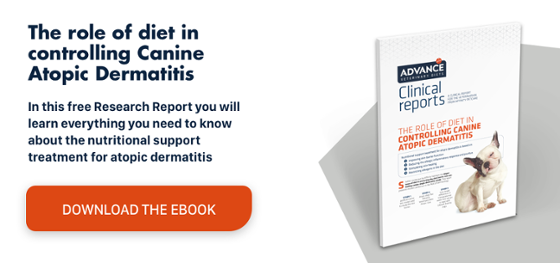Treating pruritus: nutrition in dogs with atopic dermatitis
Treating pruritus: nutritional treatment to reduce medication
While diet alone is not enough to control an acute atopic episode, it is very hard to manage the disease without a specific diet in place.
It is important to remember that atopic dermatitis (AD) is a chronic and therefore incurable disease. The continuous administration of medication for AD usually has long-term side effects that will seriously affect the animal’s quality of life and may even require breaks in treatment.
Daily preventive and maintenance treatment is therefore essential in attempts to improve the clinical signs and reduce medication.
To explain the measures used to manage AD, the following diagram summarises the two pillars of AD treatment: the specific drug therapy and supporting measures.
Atopic dermatitis in dogs. Diet as part of the therapy: how does it work?
In AD, the protective mechanisms of the skin barrier are disrupted. This, along with the intense itching suffered by the dog, creates a vicious circle of itching–scratching–inflammation.
As such, it can be understood that nutritional treatment is effective because it reduces the itch threshold.
With this in mind, the special support diet for atopic dermatitis is based on three key points:
- Protecting and improving skin barrier function
- Reducing inflammation
- Restricting allergens in the diet
Dogs with atopic skin need nutrients that strengthen the epidermal barrier, reduce inflammation and control flare-ups.
Amongst the notable ingredients in diets for AD is the content of omega-3 and 6 fatty acids, together with aloe vera gel and collagen peptides, which encourage healing of the dermal and intestinal epithelium and reduce atopic relapses.
Allergens can be restricted through antigen-limiting diets using new sources of protein (trout, kangaroo, etc.), which are more suitable for long-term consumption than hypoallergenic dog foods.
If you are interested in this point, we discussed the role of hypoallergenic diets in the treatment and diagnosis of atopic dermatitis in dogs in an earlier post. Why not have a look?
In conclusion, for vets, diet is a nonpharmacological tool that should be included in the treatment of dogs with atopic dermatitis as it makes an effective contribution to the management of the clinical signs. Furthermore, it offers owners a simple, affordable solution that improves their pet’s well-being.
“If you don’t adhere to the long-term integral treatment, that is, the specific therapy and support measures, you just end up treating acute outbreaks all the time.”

